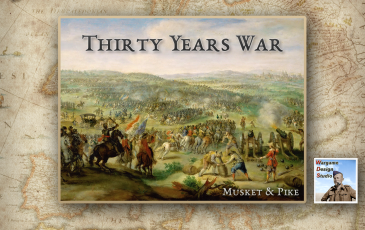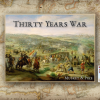045_Alte Veste - Salvo Variant - WDS Thirty Years War

64f8a9520a0c004fd5ef.jpg) 0 - 0 - 0
0 - 0 - 0
435be480296def0cb8f9.jpg)
| Rating: | 0 (0) |
| Games Played: | 0 |
| SM: | 4 |
| Turns: | 44 |
| Type: | Stock |
| First Side: | Anti-Imperialist (TYW) |
| Second Side: | Imperialist (TYW) |
Date: 3rd September 1632 - Size: Medium - Location: S/W of Nurnberg
Scenario Briefing: Alte Veste: Swedish Assault - After his victory at Rain (or the River Lech) in April, Gustavus had persuaded Augsburg to capitulate, but Maximilian had been able to secure the impregnable fortress of Ingolstadt and also Regensburg, effectively preventing the Swedes from controlling Bavaria. The Swedish king, having failed to take Ingolstadt, sacked Munich and ravaged Bavaria. Meanwhile, Wallenstein had assembled a fresh Imperial army and was determined to detach Saxony from its Swedish alliance. Under pressure from Wallenstein's and Pappenheim's forces, Johann Georg of Saxony warned Gustavus that without his assistance he would be forced to surrender and, since this would also cut communications with Sweden, Gustavus promptly marched north to Saxony.
However, due to poor intelligence and reconnaissance - the Swedish king's cavalry were powerful on the battlefield, but markedly inferior in scouting and raiding - Maximilian's Bavarians were able to join forces with Wallenstein. Now outnumbered, Gustavus dug in at Nuremberg and waited for reinforcements. Reluctant to attack Gustavus' defensive position, Wallenstein established his own fortified camp at nearby Alte Veste. Once Gustavus had concentrated his forces by drawing in large numbers of troops from other minor theatres of conflict, he had amassed the largest army he would ever command - some 28,000 foot, 17,000 cavalry and 175 guns. But with supplies limited and dwindling, he would need to attack and defeat Wallenstein promptly or his army would either starve or be forced to disperse again. Wallenstein's camp was strongly defended and he had slightly more infantry - perhaps as many as 32,000 - but only 12,000 cavalry and less guns. Gustavus' preliminary move was to secure the Imperialist-held village of Furth on 31st August and drive in Wallenstein's other outposts before establishing three artillery batteries of over 70 guns overnight. As anticipated, the artillery duel of 1st September forced Wallenstein to pull back the Imperialist guns. But he was able to redeploy them where they were safe from enemy artillery fire yet ready to shoot at any advancing infantry, forcing Gustavus to devise a new plan of attack. Reckless and over-confident, the Swedish king decided to attack through the woods against the strongest point in the Imperialist position! Gustavus relied on surprise and determination to break into the Imperialist fortifications, but Aldringer was ready for him.
Recommended Rules: Default
Note: This scenario is best played as an Anti-Imperialist (Swedish) player against the A/I.
Note: The Swedish pikemen and regimental guns had considerable difficulty moving through the woods and took little part in the battle, so these start out fixed. This scenario uses the Salvo pdt, with increased fire factors for Salvo muskets but no defensive fire capability.
Scenario Briefing: Alte Veste: Swedish Assault - After his victory at Rain (or the River Lech) in April, Gustavus had persuaded Augsburg to capitulate, but Maximilian had been able to secure the impregnable fortress of Ingolstadt and also Regensburg, effectively preventing the Swedes from controlling Bavaria. The Swedish king, having failed to take Ingolstadt, sacked Munich and ravaged Bavaria. Meanwhile, Wallenstein had assembled a fresh Imperial army and was determined to detach Saxony from its Swedish alliance. Under pressure from Wallenstein's and Pappenheim's forces, Johann Georg of Saxony warned Gustavus that without his assistance he would be forced to surrender and, since this would also cut communications with Sweden, Gustavus promptly marched north to Saxony.
However, due to poor intelligence and reconnaissance - the Swedish king's cavalry were powerful on the battlefield, but markedly inferior in scouting and raiding - Maximilian's Bavarians were able to join forces with Wallenstein. Now outnumbered, Gustavus dug in at Nuremberg and waited for reinforcements. Reluctant to attack Gustavus' defensive position, Wallenstein established his own fortified camp at nearby Alte Veste. Once Gustavus had concentrated his forces by drawing in large numbers of troops from other minor theatres of conflict, he had amassed the largest army he would ever command - some 28,000 foot, 17,000 cavalry and 175 guns. But with supplies limited and dwindling, he would need to attack and defeat Wallenstein promptly or his army would either starve or be forced to disperse again. Wallenstein's camp was strongly defended and he had slightly more infantry - perhaps as many as 32,000 - but only 12,000 cavalry and less guns. Gustavus' preliminary move was to secure the Imperialist-held village of Furth on 31st August and drive in Wallenstein's other outposts before establishing three artillery batteries of over 70 guns overnight. As anticipated, the artillery duel of 1st September forced Wallenstein to pull back the Imperialist guns. But he was able to redeploy them where they were safe from enemy artillery fire yet ready to shoot at any advancing infantry, forcing Gustavus to devise a new plan of attack. Reckless and over-confident, the Swedish king decided to attack through the woods against the strongest point in the Imperialist position! Gustavus relied on surprise and determination to break into the Imperialist fortifications, but Aldringer was ready for him.
Recommended Rules: Default
Note: This scenario is best played as an Anti-Imperialist (Swedish) player against the A/I.
Note: The Swedish pikemen and regimental guns had considerable difficulty moving through the woods and took little part in the battle, so these start out fixed. This scenario uses the Salvo pdt, with increased fire factors for Salvo muskets but no defensive fire capability.





















